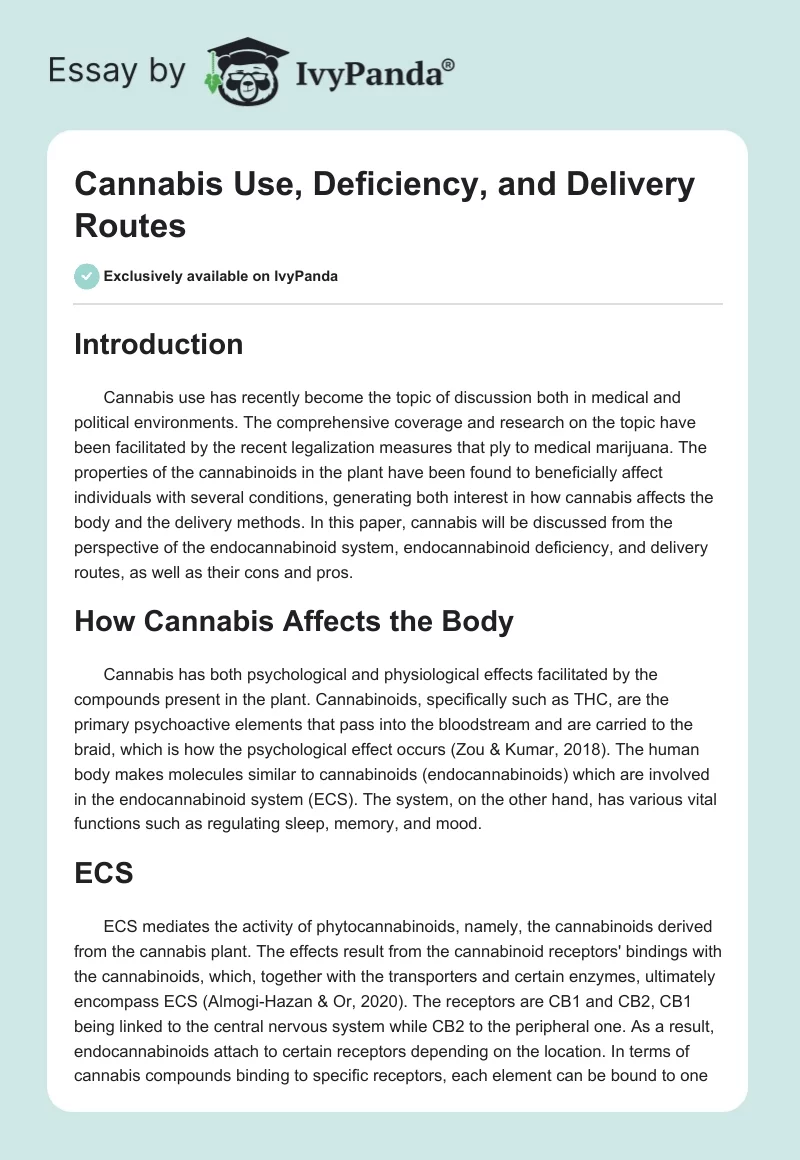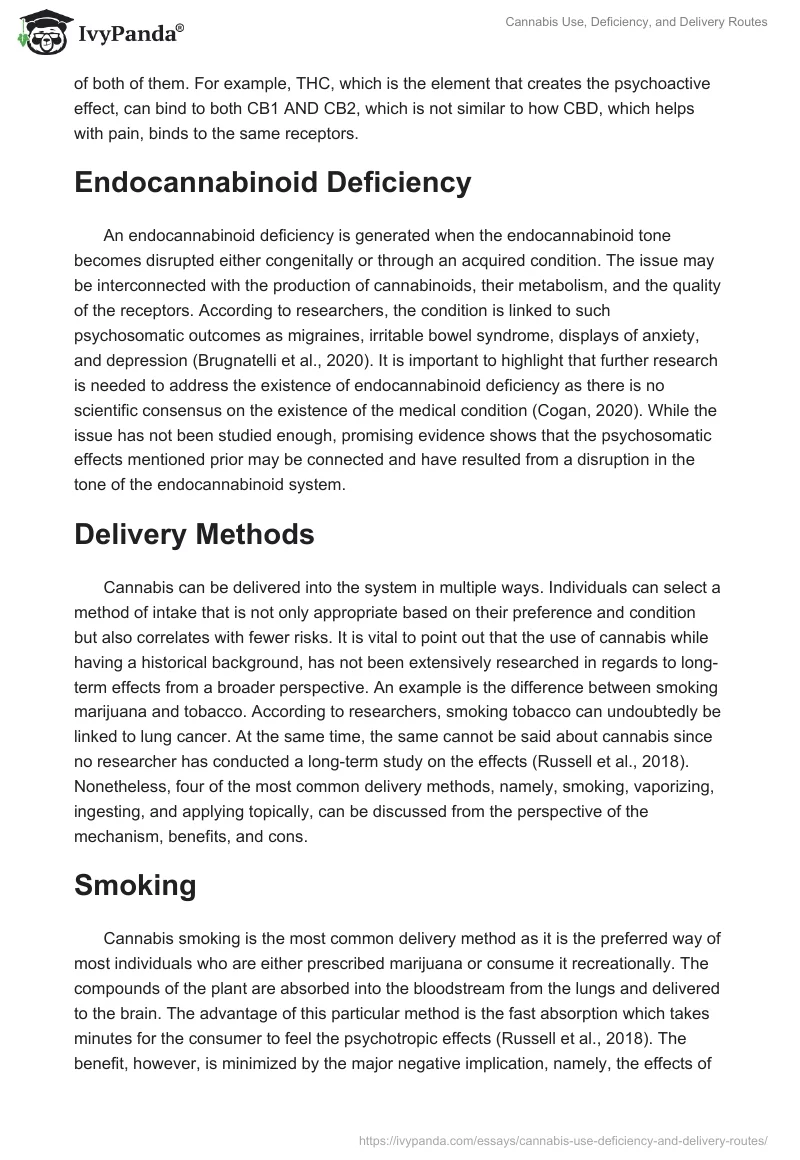Introduction
Cannabis use has recently become the topic of discussion both in medical and political environments. The comprehensive coverage and research on the topic have been facilitated by the recent legalization measures that ply to medical marijuana. The properties of the cannabinoids in the plant have been found to beneficially affect individuals with several conditions, generating both interest in how cannabis affects the body and the delivery methods. In this paper, cannabis will be discussed from the perspective of the endocannabinoid system, endocannabinoid deficiency, and delivery routes, as well as their cons and pros.
How Cannabis Affects the Body
Cannabis has both psychological and physiological effects facilitated by the compounds present in the plant. Cannabinoids, specifically such as THC, are the primary psychoactive elements that pass into the bloodstream and are carried to the braid, which is how the psychological effect occurs (Zou & Kumar, 2018). The human body makes molecules similar to cannabinoids (endocannabinoids) which are involved in the endocannabinoid system (ECS). The system, on the other hand, has various vital functions such as regulating sleep, memory, and mood.
ECS
ECS mediates the activity of phytocannabinoids, namely, the cannabinoids derived from the cannabis plant. The effects result from the cannabinoid receptors’ bindings with the cannabinoids, which, together with the transporters and certain enzymes, ultimately encompass ECS (Almogi-Hazan & Or, 2020). The receptors are CB1 and CB2, CB1 being linked to the central nervous system while CB2 to the peripheral one. As a result, endocannabinoids attach to certain receptors depending on the location. In terms of cannabis compounds binding to specific receptors, each element can be bound to one of both of them. For example, THC, which is the element that creates the psychoactive effect, can bind to both CB1 AND CB2, which is not similar to how CBD, which helps with pain, binds to the same receptors.
Endocannabinoid Deficiency
An endocannabinoid deficiency is generated when the endocannabinoid tone becomes disrupted either congenitally or through an acquired condition. The issue may be interconnected with the production of cannabinoids, their metabolism, and the quality of the receptors. According to researchers, the condition is linked to such psychosomatic outcomes as migraines, irritable bowel syndrome, displays of anxiety, and depression (Brugnatelli et al., 2020). It is important to highlight that further research is needed to address the existence of endocannabinoid deficiency as there is no scientific consensus on the existence of the medical condition (Cogan, 2020). While the issue has not been studied enough, promising evidence shows that the psychosomatic effects mentioned prior may be connected and have resulted from a disruption in the tone of the endocannabinoid system.
Delivery Methods
Cannabis can be delivered into the system in multiple ways. Individuals can select a method of intake that is not only appropriate based on their preference and condition but also correlates with fewer risks. It is vital to point out that the use of cannabis while having a historical background, has not been extensively researched in regards to long-term effects from a broader perspective. An example is the difference between smoking marijuana and tobacco. According to researchers, smoking tobacco can undoubtedly be linked to lung cancer. At the same time, the same cannot be said about cannabis since no researcher has conducted a long-term study on the effects (Russell et al., 2018). Nonetheless, four of the most common delivery methods, namely, smoking, vaporizing, ingesting, and applying topically, can be discussed from the perspective of the mechanism, benefits, and cons.
Smoking
Cannabis smoking is the most common delivery method as it is the preferred way of most individuals who are either prescribed marijuana or consume it recreationally. The compounds of the plant are absorbed into the bloodstream from the lungs and delivered to the brain. The advantage of this particular method is the fast absorption which takes minutes for the consumer to feel the psychotropic effects (Russell et al., 2018). The benefit, however, is minimized by the major negative implication, namely, the effects of smoking on the respiratory system. Similar to cigarettes, cannabis contains carbon monoxide, and the smoking method leads to the accumulation of tar on the walls of the lungs.
Vaporizing
Vaporizing cannabis is similar to smoking it in terms of the absorption of the compounds into the system through the lungs, bloodstream, and ultimately, the brain. However, smoke is the result of combustion, which is not the case for the heating process correlating with the action of vaporizing cannabis oil (Russell et al., 2018). Moreover, it produces less carbon monoxide compared to the smoking process, which is another benefit. Nonetheless, the transmission method is relatively non-researched due to the new occurrence of this particular delivery framework. Moreover, researchers mention that the vaporizing process has a delayed impairment (Russell et al., 2018). Thus, both pros and cons are linked to cannabis consumption through vaporizing.
Ingesting Edibles
Ingesting cannabis is another method of transmission that can be applied by users of the plant or its compounds. However, it is absorbed differently as it passes through the stomach to the liver, bloodstream, and, ultimately, the brain. Edibles do not have the harmful respiratory effects commonly associated with smoking, and the effect usually lasts longer than through the vaporization of the oil (Russell et al., 2018). However, since the products are challenging to formulate adequately, overconsumption is common, which can lead to excessive psychoactive effects. The negative aspect can result in episodes of psychosis, anxiety, and other adverse psychological outcomes.
Applying Topically
Applying cannabis compounds topically is a delivery method that implies the cream, oil, or substance is transferred onto the skin, absorbed, and transmitted through the brain through the bloodstream. The benefit of the method is the fact that systematic exposure is minimal, and the psychoactive effects do not occur (Patel & Lio, 2021). Pain-relieving and dermatological benefits are the primary advantageous aspects of the transmission framework. However, the delivery method lacks adequate research, which is a significant limitation that potentially compromises the solution.
Conclusion
Cannabis use has been discussed in relation to the reaction of the endocannabinoid system, the evidence for the existence of endocannabinoid deficiency, and the delivery methods. ECS mediates the activity of phytocannabinoids, while a systematic disruption in the tone of the system creates health issues that researchers argue correlate with the said system. Phytocannabinoids can be delivered through several routes, namely by smoking, vaporizing, ingesting, and applying the compounds topically. Based on the analysis, vaporizing is the method that correlates with the least harmful effects, while the most maximized benefits as a reduction in damage to the respiratory system compared to smoking can be highlighted alongside the fast absorption compared to ingesting edibles or applying cannabis compounds topically.
References
Almogi-Hazan, O., & Or, R. (2020). Cannabis, the endocannabinoid system and immunity—the journey from the bedside to the bench and back.International Journal of Molecular Sciences, 21(12), 4448. Web.
Brugnatelli, V., Turco, F., Freo, U., & Zanette, G. (2020). Irritable bowel syndrome: Manipulating the endocannabinoid system as first-line treatment. Frontiers in Neuroscience, 14. Web.
Cogan, P. S. (2020). Practical considerations of hypotheses and evidence in cannabis pharmacotherapy: Refining expectations of clinical endocannabinoid deficiency.Journal of Dietary Supplements, 17(5), 608–624. Web.
Patel, P. M., & Lio, P. A. (2021). Safety and sourcing of topical cannabinoids: Many questions, few answers. Journal of Clinical and Aesthetic Dermatology, 14(8), 49–51.
Russell, C., Rueda, S., Room, R., Tyndall, M., & Fischer, B. (2018). Routes of administration for cannabis use – basic prevalence and related health outcomes: A scoping review and synthesis.International Journal of Drug Policy, 52, 87–96. Web.
Zou, S., & Kumar, U. (2018). Cannabinoid receptors and the endocannabinoid system: Signaling and function in the central nervous system.International Journal of Molecular Sciences, 19(3), 833. Web.


